
The ACT Reading section is challenging for many students because of the intense focus required to answer questions accurately in such a short time frame. Quickly getting to the root of each question is tough, but it's definitely a skill that you can learn with practice. This guide will present an example-driven step-by-step process for interpreting ACT Reading questions and give you the inside scoop on some of the sneakiest tricks the Reading section has up its sleeve.
What’s in This Guide, and Who Is It For?
This guide provides a step-by-step outline of how to approach ACT Reading questions and determine exactly what they’re asking. The steps can also function as tips in isolation. You won’t need to complete all of them for every question (especially because the ACT is so fast-paced and the questions are typically pretty straightforward), but I think understanding this process before the test will help you to get through questions that confuse you at first glance.
The second part of the article lists a few tricks the ACT Reading section has up its sleeve. You should learn to spot them so you can avoid making careless mistakes. If you tend to have difficulty with the ACT Reading section (or reading isn't your strong suit in general), I’d recommend taking a look at the steps and tips in this article. They'll give you a nice confidence boost on the test!
Step-By-Step: How to Break Down ACT Reading Questions
This is a comprehensive step-by-step process that you can use to understand and answer ACT Reading questions. Here’s the question I’ll be using as an example:
Which of the following most clearly distinguishes between the “two ways” suggested by the author’s assertion that “we can’t have it both ways” (line 54)?
A. Women haven’t until recently been allowed to see the depths in Shakespeare, but nobody bothers to read Shakespeare anyway.
B. Women haven’t written as well as men because they’ve been too busy being spouses, but nobody takes time to read women writers anyway.
C. Women haven’t written as well as men because they have not had the same educational opportunities, yet there are many great women writers no one reads.
D. Women have always had an abundance of Shakespeares, yet have not experienced the kind of education it takes to appreciate Shakespeare.
Step 1: Do a Quick Read of the Question (and the Relevant Line Numbers If Applicable)
First, read the question to get a more general sense of what it’s asking. On the ACT, many questions are clearly worded, so it’s not necessary to go through all the additional steps to interpret them. This should serve as a checkpoint to gauge the difficulty level of the question and how much time you need to spend dissecting its meaning.
If you’re given a line reference number, revisit the line and the paragraph where it occurs to jog your memory about the context. Here’s the paragraph we need to revisit for this question (line 54 is bolded):
For the fact is that we can’t have it both ways. We can’t simultaneously espouse the line that women haven’t until recently been allowed the depth of education and experience to become Shakespeare, while also claiming that we really have an abundance of Shakespeares, if anybody would just take the time to read us.
Now that you've grounded yourself with a basic idea of what you’re looking for, you can dig into the meat of the question (ew).

This is what I pictured while writing that last sentence (and it's also what the expression on my face looked like).
Step 2: Underline Important Terms and Phrases
Let's start looking at the nitty-gritty of what exactly the question is asking. In this step, we'll underline the most important terms and phrases. These might include:
Words and phrases that indicate main idea or detail questions:
- Summarizes
- Lists
- States
- Paraphrases
- Main point
- Primary purpose
- Point of view
- [Number] paragraph
- EXCEPT or LEAST
- Compare or contrast
Words and phrases that indicate inference questions:
- Can be inferred
- Suggests
- Implies
- Is meant to
- Represents
- [Most nearly] means
Words and phrases that indicate questions about author/character intention or feelings:
- Establishes
- Indicates
- Illustrates
- Distinguishes between
- ([Character] or [author]) feels
- Could be characterized
- Agree or disagree
- Mood and tone
For the sample question, these are the parts I would underline:
Which of the following most clearly distinguishes between the “two ways” suggested by the author’s assertion that “we can’t have it both ways” (line 54)?
We know for this question we’re looking for a description of the contrast between the “two ways” cited in the passage. The function of the correct answer choice (distinguishing between), the actual subject of the question (“two ways”), and the reference spot in the passage (line 54) are the key aspects of this question that could be underlined for clarity.
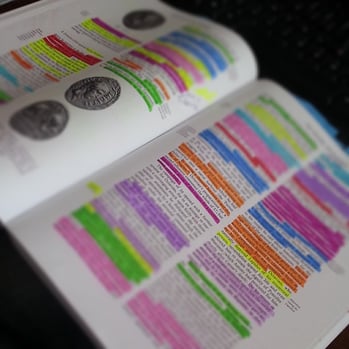 Important tip: Don't underline a million things in the question. This step is useless if you're not emphasizing specific parts. In a parallel case, whoever overzealously highlighted this book is going to be extremely frustrated when they try to study later.
Important tip: Don't underline a million things in the question. This step is useless if you're not emphasizing specific parts. In a parallel case, whoever overzealously highlighted this book is going to be extremely frustrated when they try to study later.
Step 2.5: Rephrase the Question (If Necessary)
This is an optional step that I would suggest taking if you still aren’t completely confident that you understand what the question is asking. Since you’ve underlined the most important parts, you should be able to rephrase it in a way that’s more easily digestible. For the sample question, this might look something like:
Which answer choice describes the contrast between the “two ways” outlined by the author in the 5th paragraph?
At this point, you have enough information to start thinking about potential answers.
Step 3: Consider Relevant Evidence in the Passage and Make an Answer Prediction
Now that we know what the question is asking, it’s time to look back at the passage and see if we can make any predictions about the answer. Look at the surrounding context, not just the specific line or lines mentioned in the question. Once again, here’s the paragraph we need to look at to find the answer to this question:
For the fact is that we can’t have it both ways. We can’t simultaneously espouse the line that women haven’t until recently been allowed the depth of education and experience to become Shakespeare, while also claiming that we really have an abundance of Shakespeares, if anybody would just take the time to read us.
The incompatible “two ways” described in the paragraph are:
1. Women haven’t been given the same educational opportunities as men, and this accounts for the existence of fewer famous female writers.
2. There are just as many female literary greats out there as male, but their works are ignored by society because of gender bias.
The answer choice that we’re looking for will present the incompatibility of these two conceptions of the situation. It would be something like:
Women don’t produce as many great works of literature as men due to lack of educational opportunity.
Vs.
Women’s contributions to literature would be considered as great as men if their work was given more exposure.
 *Writes great work of literature only to realize it's been smudged beyond recognition by absurdly puffy dress sleeves*
*Writes great work of literature only to realize it's been smudged beyond recognition by absurdly puffy dress sleeves*
Step 4: Eliminate Incorrect Answer Choices
We know what we’re looking for, so we can move on to ruling out three of the four answer choices:
Which of the following most clearly distinguishes between the “two ways” suggested by the author’s assertion that “we can’t have it both ways” (line 54)?
A. Women haven’t until recently been allowed to see the depths in Shakespeare, but nobody bothers to read Shakespeare anyway.
B. Women haven’t written as well as men because they’ve been too busy being spouses, but nobody takes time to read women writers anyway.
C. Women haven’t written as well as men because they have not had the same educational opportunities, yet there are many great women writers no one reads.
D. Women have always had an abundance of Shakespeares, yet have not experienced the kind of education it takes to appreciate Shakespeare.
Let's go through each of these choices based on the information we've learned so far:
Choice A can be eliminated because the “two ways” have nothing to do with Shakespeare’s works specifically. Shakespeare is only mentioned as a stand-in for famous writers in general. Although the first part of the answer is almost in line with one of the issues mentioned (women not having access to education), the second part doesn’t work.
Choice B can be eliminated because of the first part of the sentence. The author doesn’t say anything about women being too busy being spouses to craft great works of literature.
Choice C looks correct based on our predictions. It checks out both for the first claim (women haven’t written as well because they haven’t had the same educational opportunities as men) and the second claim (there are lots of great women writers out there, but no one gives them a chance).
Choice D can be eliminated because it’s too focused on the Shakespeare aspect of the author's statement. As I said earlier, Shakespeare is used simply as a representative for all well-known and well-respected literary talents.
 How do we know Shakespeare wasn't just a bearded lady? I imagine hair removal was more difficult back then, and this is one pretty dude.
How do we know Shakespeare wasn't just a bearded lady? I imagine hair removal was more difficult back then, and this is one pretty dude.
Step 5: Commit to a Final Answer
Based on our findings in the previous step, it looks like Choice C is the one we want. Before bubbling it in, read over the question and chosen answer one last time to ensure that everything makes sense, and there are no careless mistakes. It's always a good idea to double check the question and answer before you commit so that you don't miss anything!
Not So Fast...Look Out for These Tricks
If you follow the steps in this article, you shouldn’t fall for the ACT’s tricks, but considering the fast-paced nature of the test, you’re bound to rush through a few questions. If you don’t pay attention to exactly what the question is asking and what the evidence tells you, you could run into trouble. Be wary of:
Half-Correct Answers
Often when the answer to a question has two or more parts, some of the choices will be partially correct. This can be tricky because you might start reading an answer choice, notice that it lines up with what you predicted for the answer, and bubble it in without noticing that part of it doesn’t make sense.
This could have happened on the question we just answered. In Choice A, the first part of the answer made some sense, but we found that the second part was wrong, and Choice C was actually the correct answer. To avoid falling for this trick, read through all parts of every possible answer carefully before committing to your choice.
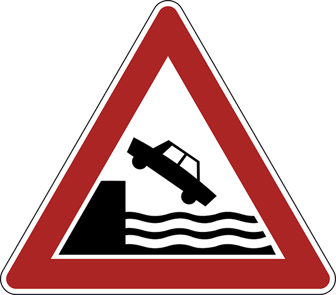 This looks like a nice solid roaaaaaaaahhhhhh (metaphorical representation of what will happen if you don't read carefully)
This looks like a nice solid roaaaaaaaahhhhhh (metaphorical representation of what will happen if you don't read carefully)
Superfluous Details (or Overly Specific Ones)
Sometimes the ACT likes to insert little sneaky incorrect details into answers that look correct at first glance. Take this question, for example:
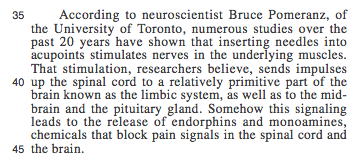
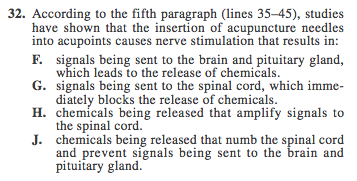
Choice F is the correct answer even though Choice J may appear more specific and accurate if you don’t look at the details too closely. Choice J mentions numbing the spinal cord, which is a more detailed description of the process than Choice F’s generic “release of chemicals.” However, its inclusion of the pituitary gland in the second part of the answer makes it incorrect.
The chemicals do “block pain signals in the spinal cord,” but the pituitary gland is only referenced when the passage states that acupoint stimulation sends impulses there. The chemicals don’t prevent signals from being sent to the pituitary gland, so Choice J is wrong-o. To avoid falling for this, use process of elimination to rule out all answers that give even the tiniest extra details that don’t make sense in the context of the passage.
 I wonder how acupuncture was even discovered in the first place. If I'm trying to get some pain relief, the last thing I think about is stabbing myself with tiny needles.
I wonder how acupuncture was even discovered in the first place. If I'm trying to get some pain relief, the last thing I think about is stabbing myself with tiny needles.
LEAST or EXCEPT Questions
Some questions on the ACT will ask you what the answer is NOT. This is perhaps the most classic variety of tricky question. Here's an example:
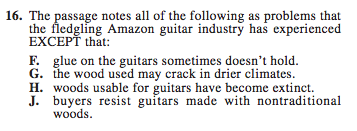
Even though the words "least" and "except" are in all caps, many students miss these key words by not reading carefully enough. If you notice a LEAST or EXCEPT in a question, make that the first thing you underline. As you go through the answer choices, clearly cross out any options that accurately reflect the information in the passage. These questions are generally on the easier side if you don't get confused by the trick!
Objective Truths (but Inaccurate Answers)
The ACT likes to include answers on the Reading section that might look good to you if you skipped straight to the questions. These answers include real facts or very reasonable assumptions that would look like logical choices if you didn’t consult the passage directly. Here's an example:
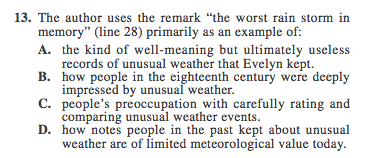
If you were rushing through this passage and only looked at the question, you might be tempted by almost all of these choices.
Choice A includes a specific name, which makes it seem like it's directly related to the passage. Choice B also sounds logical at first glance. People in the 18th century were probably impressed by unusual weather because there wasn’t that much else around for entertainment value. Choice C is kind of weird, so it’s a less likely temptation, but it’s still something that you could think was plausibly true.
Here’s the actual section of the passage the question references:
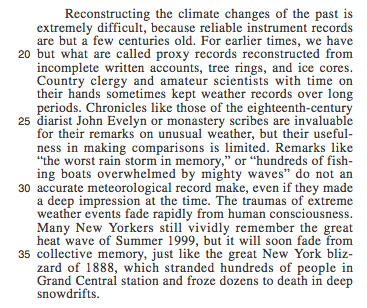
Choice D is the correct answer because it accurately explains the purpose of the quote in the context of the author’s larger point. But you can see how the “truthiness” of the first few choices might confuse you if you didn’t read thoroughly.
ALWAYS be vigilant in your search for direct evidence. Just because something is true or logical out of context doesn’t mean it’s the answer you want!
 Prepare for the best BRAINstorm in memory on the ACT.
Prepare for the best BRAINstorm in memory on the ACT.
Conclusion
Reading questions on the ACT can be misleading at times, so it's smart to have an effective way of breaking them down before you take the test. Once again, here are the steps you might take to dissect and conquer challenging questions:
- Step 1: Do a Quick Read of Question (and Relevant Line Numbers if Applicable)
- Step 2: Underline Important Terms and Phrases
- Step 2.5: Rephrase the Question
- Step 3: Consider Relevant Evidence in the Passage and Make an Answer Prediction
- Step 4: Eliminate Incorrect Answer Choices
- Step 5: Commit to a Final Answer
As you follow these steps, be on the lookout for ACT tricks that might throw you for a loop. Examples include:
- Half-Correct Answers
- Superfluous Details (or Overly Specific Ones)
- LEAST or EXCEPT Questions
- Objective Truth (but Inaccurate Answer)
What's Next?
Want more tips? Check out our ultimate prep guide to ACT Reading, which includes every article we've written about this topic.
If you're in a time crunch, read this article on how to cram for the ACT and (potentially) raise your score 4 points in 10 days!
Practice tests are the most critical study weapons you have in your arsenal. Learn how you can use ACT practice tests to improve your score in just 20 hours.
Want to improve your SAT score by 160 points?
Check out our best-in-class online SAT prep program. We guarantee your money back if you don't improve your SAT score by 160 points or more.
Our program is entirely online, and it customizes what you study to your strengths and weaknesses. If you liked this Reading lesson, you'll love our program. Along with more detailed lessons, you'll get thousands of practice problems organized by individual skills so you learn most effectively. We'll also give you a step-by-step program to follow so you'll never be confused about what to study next.
Check out our 5-day free trial:
Have friends who also need help with test prep? Share this article!

Samantha is a blog content writer for PrepScholar. Her goal is to help students adopt a less stressful view of standardized testing and other academic challenges through her articles. Samantha is also passionate about art and graduated with honors from Dartmouth College as a Studio Art major in 2014. In high school, she earned a 2400 on the SAT, 5's on all seven of her AP tests, and was named a National Merit Scholar.


































 Holly R.
Holly R.